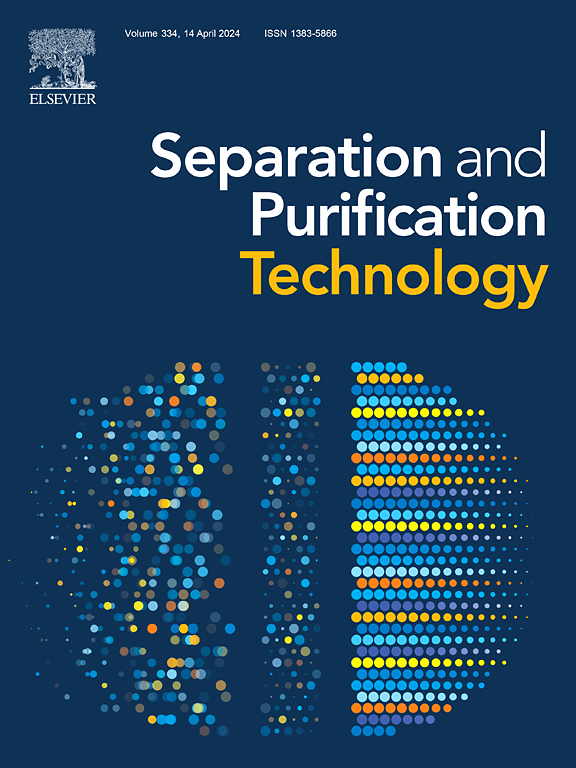Degradation of carbamazepine in reverse osmosis concentrate of the secondary effluent by electrochlorination and its reaction mechanism
IF 8.1
1区 工程技术
Q1 ENGINEERING, CHEMICAL
引用次数: 0
Abstract
Reverse osmosis concentrate (ROC) from the secondary effluent in municipal wastewater reclamation contains emerging pollutants (EPs) that require further treatment, as these EPs may otherwise pose risks to human health and ecological balance. Since ROC has relatively high salinity, Electrochlorination (E-Cl) could exactly be a promising technology for its EPs removal. However, a comprehensive and systematic investigation has yet to be carried out. In this study, targeted at E-Cl process for the ROC treatment, a series of conscientiously designed experiments were conducted to evaluate the removal performance of carbamazepine (CBZ), investigate the effects of operating conditions and water matrix on the CBZ removal, and reveal its reaction mechanisms. An excellent CBZ removal efficiency of 99.8 % was achieved within 30 min at 2 mA cm−2 in 5 mM NaCl solution. Among water matrix components, SO42-, NO3–, PO43- and NH4+ showed minimal effects, whereas HCO3– and humic acid had significant influences on the CBZ removal. The roles of ClO• and Cl2•- radicals in the E-Cl process were clarified through quenching experiments combined with electron paramagnetic resonance and radical probe tests. The steady-state concentrations of ClO• (88.95 × 10-14 M) and Cl2•- (493.02 × 10-14 M) were much higher than those of HO• (6.91 × 10-14 M). Both ClO• and Cl2•- played key roles in CBZ degradation in the E-Cl process. Probable degradation pathways of CBZ were proposed based on the intermediates identification and density function theory (DFT) calculations. This study demonstrates the potential of E-Cl systems for effective EPs removal in ROC, providing mechanistic insights for practical applications.


城市污水再生中二级出水的反渗透浓缩物(ROC)含有新出现的污染物(EPs),需要进一步处理,否则这些污染物可能会对人类健康和生态平衡造成危害。由于 ROC 的含盐量相对较高,电氯化法(E-Cl)正是一种很有前景的去除 EPs 的技术。然而,目前尚未开展全面系统的研究。本研究针对电氯化法处理 ROC 的问题,进行了一系列精心设计的实验,以评估卡马西平(CBZ)的去除性能,研究操作条件和水基质对 CBZ 去除的影响,并揭示其反应机理。在 5 mM NaCl 溶液中,在 2 mA cm-2 的条件下,30 分钟内 CBZ 的去除率达到 99.8%。在水基质成分中,SO42-、NO3-、PO43-和NH4+对CBZ的去除影响很小,而HCO3-和腐殖酸对CBZ的去除影响很大。通过淬灭实验结合电子顺磁共振和自由基探针测试,阐明了 ClO- 和 Cl2--自由基在 E-Cl 过程中的作用。ClO-(88.95 × 10-14 M)和Cl2--(493.02 × 10-14 M)的稳态浓度远高于HO-(6.91 × 10-14 M)。ClO-和Cl2-在E-Cl过程中对CBZ的降解起着关键作用。根据中间产物鉴定和密度函数理论(DFT)计算,提出了 CBZ 的可能降解途径。这项研究证明了 E-Cl 系统在 ROC 中有效去除 EPs 的潜力,为实际应用提供了机理启示。
本文章由计算机程序翻译,如有差异,请以英文原文为准。
求助全文
约1分钟内获得全文
求助全文
来源期刊

Separation and Purification Technology
工程技术-工程:化工
CiteScore
14.00
自引率
12.80%
发文量
2347
审稿时长
43 days
期刊介绍:
Separation and Purification Technology is a premier journal committed to sharing innovative methods for separation and purification in chemical and environmental engineering, encompassing both homogeneous solutions and heterogeneous mixtures. Our scope includes the separation and/or purification of liquids, vapors, and gases, as well as carbon capture and separation techniques. However, it's important to note that methods solely intended for analytical purposes are not within the scope of the journal. Additionally, disciplines such as soil science, polymer science, and metallurgy fall outside the purview of Separation and Purification Technology. Join us in advancing the field of separation and purification methods for sustainable solutions in chemical and environmental engineering.
 求助内容:
求助内容: 应助结果提醒方式:
应助结果提醒方式:


